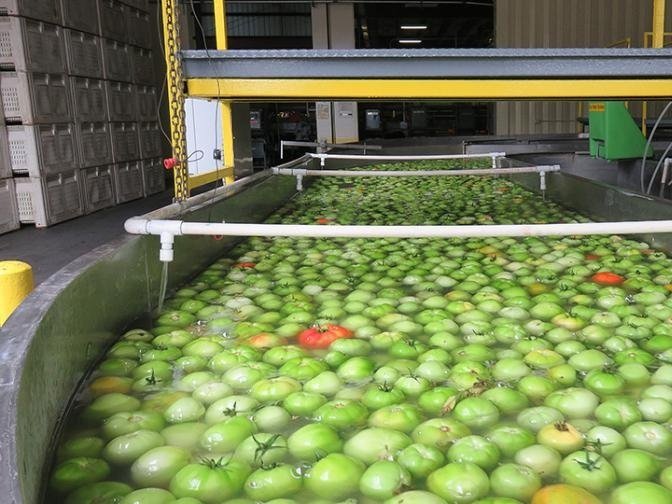Summer Heat - Food Safety Caution
High Summer Temperatures may Cause Infiltration Contamination in Produce
What is infiltration?
Infiltration is the movement of water passing into fresh produce during immersion, such as in a dump tank during postharvest handling. Factors that increase the risk of infiltration include temperature differentials, when dump tank water is cooler than the produce pulp temperature; pressure differentials or rapid pressure change, such as when produce is deeply submerged; the presence of surfacants, such as detergents or wetting agents; extended contact time with the water; and the presence of wounds or other openings in the produce.
Photo credit: Trevor Suslow
How does it occur?
During very warm seasons, harvested produce may have significant field heat and growers may use water to cool the warm produce using water dump tanks before storage and transportation. Temperature differences between produce and bulk tank water may cause infiltration. The warm produce acts as a vaccum in cold water, sucking in the water. Especially, if the produce has bruises or areas susceptiable to infiltration.
Image notes: Blue dye shows movement of cold water into the warm cantaloupe after submersion in cold wash water with dye due to infiltration.
Photo credit: Michelle Smith, FDA/CFSA
Why is Infiltration a Concern?
If bulk tank (postharvest) water is contaminated, pathogens can enter the produce with infiltrating water, resulting in a food safety risk. Pathogen infiltration into fresh produce has resulted in several food safety related outbreaks and recalls. For example, mangoes have been linked to several Salmonella outbreaks, and these outbreaks have been attributed to infiltration from contaminated water used in mango hot-water dip treatment to prevent fruit fly infestation. Infiltration is especially a concern in fresh produce that does not go through a kill step, such as cooking, before consumption.
High Risk Factors for Infiltration
1. Poor Water Quality
Contact with contaminated water could be problematic, as the produce may be not only become contaminated on the outside, but may also become contaminated on the inside by infiltration water.
2. Bruised Produce
Fruit with bruises, wounds, or large stem scars can have a greater risk of infiltration.
3. Type of Commodity
Tomatoes, cantaloupes, mangoes, and apples are commodities commonly considered to be susceptible to infiltration; however, other commodities may be susceptible too.
4. Use of Dump Tanks
There can be a higher risk of infiltration if the produce is submerged rather than sprayed with water or floated. The longer the produce is in contact with the water, the higher the risk.
Key Takeaways
Be cautious of high produce temperatures this season as the summer months get really warm. Consider harvesting produce during cooler times in the day. For postharvest, only use water that has no detectable generic E.coli. Avoid leaving produce submerged in water for long periods of time. Use a sanitizer to maintain water quality. By preventing pathogen survival in the water, you are minimizing produce safety risks associated with infiltration.

